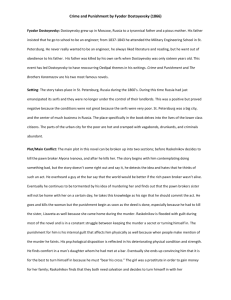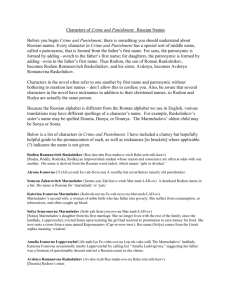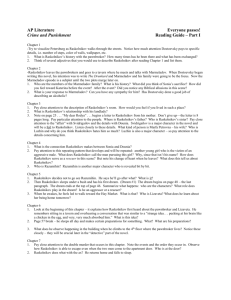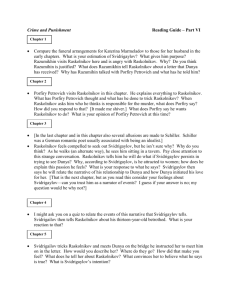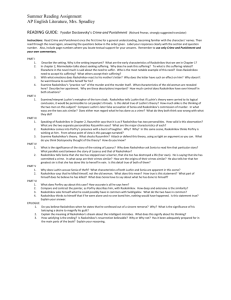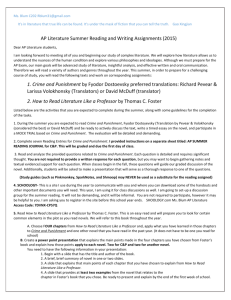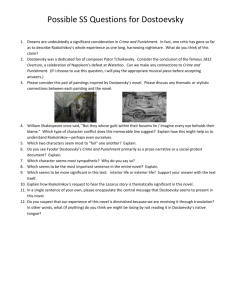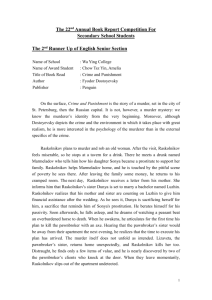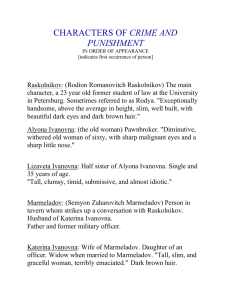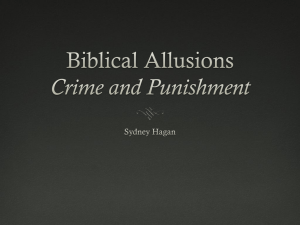Notations in your copy of Crime and Punishment
advertisement
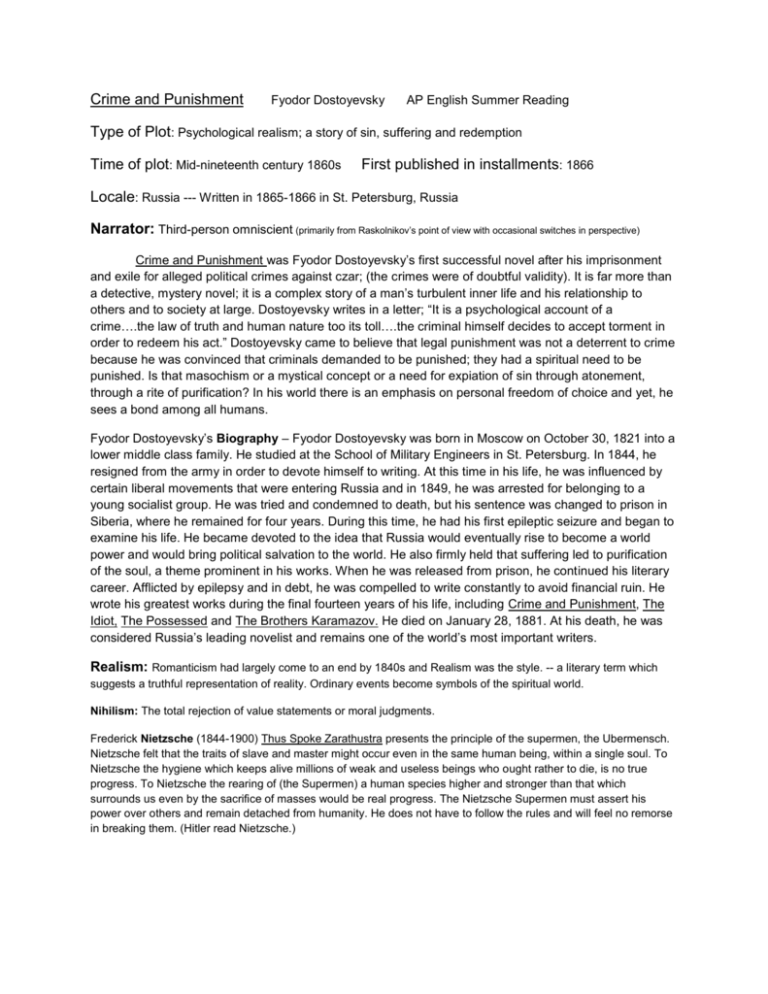
Crime and Punishment Fyodor Dostoyevsky AP English Summer Reading Type of Plot: Psychological realism; a story of sin, suffering and redemption Time of plot: Mid-nineteenth century 1860s First published in installments: 1866 Locale: Russia --- Written in 1865-1866 in St. Petersburg, Russia Narrator: Third-person omniscient (primarily from Raskolnikov’s point of view with occasional switches in perspective) Crime and Punishment was Fyodor Dostoyevsky’s first successful novel after his imprisonment and exile for alleged political crimes against czar; (the crimes were of doubtful validity). It is far more than a detective, mystery novel; it is a complex story of a man’s turbulent inner life and his relationship to others and to society at large. Dostoyevsky writes in a letter; “It is a psychological account of a crime….the law of truth and human nature too its toll….the criminal himself decides to accept torment in order to redeem his act.” Dostoyevsky came to believe that legal punishment was not a deterrent to crime because he was convinced that criminals demanded to be punished; they had a spiritual need to be punished. Is that masochism or a mystical concept or a need for expiation of sin through atonement, through a rite of purification? In his world there is an emphasis on personal freedom of choice and yet, he sees a bond among all humans. Fyodor Dostoyevsky’s Biography – Fyodor Dostoyevsky was born in Moscow on October 30, 1821 into a lower middle class family. He studied at the School of Military Engineers in St. Petersburg. In 1844, he resigned from the army in order to devote himself to writing. At this time in his life, he was influenced by certain liberal movements that were entering Russia and in 1849, he was arrested for belonging to a young socialist group. He was tried and condemned to death, but his sentence was changed to prison in Siberia, where he remained for four years. During this time, he had his first epileptic seizure and began to examine his life. He became devoted to the idea that Russia would eventually rise to become a world power and would bring political salvation to the world. He also firmly held that suffering led to purification of the soul, a theme prominent in his works. When he was released from prison, he continued his literary career. Afflicted by epilepsy and in debt, he was compelled to write constantly to avoid financial ruin. He wrote his greatest works during the final fourteen years of his life, including Crime and Punishment, The Idiot, The Possessed and The Brothers Karamazov. He died on January 28, 1881. At his death, he was considered Russia’s leading novelist and remains one of the world’s most important writers. Realism: Romanticism had largely come to an end by 1840s and Realism was the style. -- a literary term which suggests a truthful representation of reality. Ordinary events become symbols of the spiritual world. Nihilism: The total rejection of value statements or moral judgments. Frederick Nietzsche (1844-1900) Thus Spoke Zarathustra presents the principle of the supermen, the Ubermensch. Nietzsche felt that the traits of slave and master might occur even in the same human being, within a single soul. To Nietzsche the hygiene which keeps alive millions of weak and useless beings who ought rather to die, is no true progress. To Nietzsche the rearing of (the Supermen) a human species higher and stronger than that which surrounds us even by the sacrifice of masses would be real progress. The Nietzsche Supermen must assert his power over others and remain detached from humanity. He does not have to follow the rules and will feel no remorse in breaking them. (Hitler read Nietzsche.) Brief Summary: Crime and Punishment is a novel written by Russian author Fyodor Dostoevsky. Crime and Punishment focuses on Raskolnikov, a destitute student, who plans to kill Alyona Ivaovna, a despised money-lender in order to rid the world of her evil. Raskolnikov thinks himself to be a gifted, intelligent man, an extraordinary man, a superman who feels justified in his decision to murder; he sees himself above the moral constraints of common people. Immediately after the crime, Raskolnikov becomes ill, and is troubled by the memory of his actions, notably the unplanned murder of the pawnbroker’s sister, Lizaveta Ivanovna. Crime and Punishment portrays Raskolnikov’s thought processes and actions before and after the murders. The story depicts Raskolnikov’s desire to protect his sister Dunya from Svidrigailov, a despicable suitor, and from Luzhin, an arrogant cad. Raskolnikov develops and unexpected love for Sonya Marmeladov, a destitute prostitute, as he tries to receive redemption. Pronunciation Guide of Major Characters: Rodion Romanovich Raskolnikov: ……………………………....rod-YON ro-MANH-o-vich ras-KOL-nee-koff Pulkheria Aleksandrovna (his mother): ………………….………………. pool-Kyer-ee-a al-yek-SAN-drov-na Avdotya Romanovna (or Dunya; his sister): ……………..………. ahv-DOTE-ya ro-MANH-ov-na (Dune-ya) Dmitry Prokofich Razumkihin (his friend): ………...……………….…………………………. rahz-oo-MEEK-in Katerina Ivanovna Marmeladov (his second wife): …………………………... kat-yer-EE-na ee-VANH-ov-na Semyon Zakharych Marmeladov (father of Sonya): ……………………..………………… marm-ya-LAH-doff Sofya Semyonovna Marmeladov (or Sonya; his daughter): ………………………………………….....Son-ya Luzhin, Pyotr Petrovich (Dunya’s fiancé): ……..……………………………………………………… LOOZH-in Lebezyatnikov, Andrei Semyonovich (Luzhin’s roommate): …..………………………… leb-ee-ZYAT-ni-koff Svidrigailov, Arkady Ivanovich (Dunya’s employer): …….………………………………… sfee-dree-GUY-loff Marfa Petrovna (wife of Svidrigailov): …………………………………………..……… MARF-a pye-TROV-na Alyona Ivanovna (pawnbroker): ………………………………………………...…. al-YOAN-a ee-VANH-ov-na Lizaveta Ivanovna (pawnbroker’s sister): ……………………………………. lee-za-VYET-a ee-VANH-ov-na Porfiry Petrovich (investigator): …………………………………………………… por-FEAR-ee pye-TROV-ich Zamyotov (police clerk): ………………………………………………………………………….. zahm-YOTE-off Ilya Petrovich (superintendent’s auiliary, “Explosive Lieutenant”): …………………... EEL-ya pye-TROV-ich Nikodim Fomich (police district superintendent): ………………………………….. NEEK-o-DEEM FOAM-ich Zosimov (doctor): ...…………………………………………………………………………………....zo-SEE-moff Notations in your copy of Crime and Punishment On each day of the scheduled tests for the 6 parts of this novel, I will be collecting your copy of Crime and Punishment to check the notations you are making as you read. You should be highlighting and making marginal notes on the subjects listed below. Make sure that you put a color-coded key in the front of your book so that I know which highlighted sections apply to which theme. 1. Everyday life in Russia: details that show how the people lived, how they treat one another. Do you find any stereotypes? What do they drink and eat? What part does religion play in their lives? What occupations do you see? What seems apparent about the class structure? 2. Allusions and Images: there are many allusions (Biblical primarily), images and symbols that occur over again in this text. Note them and look at the pattern. 3. Raskolnikov and his split personality: this character is full of contradictions. Note the situations and thought patterns that make up this complex man. Questions For Crime and Punishment 1. How does the physical description of Raskolnikov’s living conditions enhance or detract from the plot development occurring in this chapter? 2. Describe the meeting of Raskolnikov and Marmeladov. 3. The letter from Raskolnikov’s mother puts him in an absolute rage. Why? What is in it that makes him so furious? 4. Describe the dream with the mare. 5. What conversation does Raskolnikov overhear that gives him new inspiration for his “project”? 6. What unexpected event happens when he commits the crime? How does he handle himself? 7. How does the physical description of Raskolnikov’s living conditions enhance or detract from the plot development occurring in this chapter? 8. Describe the meeting of Raskolnikov and Marmeladov. 9. The letter from Raskolnikov’s mother puts him in an absolute rage. Why? What is in it that makes him so furious? 10. Describe the dream with the mare. 11. What conversation does Raskolnikov overhear that gives him new inspiration for his “project”? 12. What unexpected event happens when he commits the crime? How does he handle himself? 13. Describe the scene in the police station after Raskolnikov was summoned to appear there. 14. Razhumikin becomes a foil for Raskolnikov as the novel prpgresses. What are the obvious similarities and differences between the two characters at this juncture in the book. 15. Describe the discussion of the murders that took place between Raskolnikov and Zametov. At the end of the conversation, what conclusions did Zametov come to? 16. Describe the death of Marmeladov. 17. What is the conflict between Luzhin and Raskolnikov. Discuss both sides of the conflict in your response. 18. Describe the scene in the police station after Raskolnikov was summoned to appear there. 19. Razhumikin becomes a foil for Raskolnikov as the novel prpgresses. What are the obvious similarities and differences between the two characters at this juncture in the book. 20. Describe the discussion of the murders that took place between Raskolnikov and Zametov. At the end of the conversation, what conclusions did Zametov come to? 21. Describe the death of Marmeladov. 22. What is the conflict between Luzhin and Raskolnikov. Discuss both sides of the conflict in your response. 23. Discuss the new love triangle that develops at the beginning of part three. 24. What is the ultimatum that Rakolnikov gives to Dounia and why does he resort to that tactic? 25. Describe the interactions between Porfiry and Raskolnikov. 26. What is Raskolnikov’s “Extraordinary Man” theory? 27. At the end of part three, Raskolnikov is hallucinating and ranting. Explain who and what he is raving about. 28. Discuss the new love triangle that develops at the beginning of part three. 29. What is the ultimatum that Rakolnikov gives to Dounia and why does he resort to that tactic? 30. Describe the interactions between Porfiry and Raskolnikov. 31. What is Raskolnikov’s “Extraordinary Man” theory? 32. At the end of part three, Raskolnikov is hallucinating and ranting. Explain who and what he is raving about. 33. What is Svidrigailov’s story? How did he end up in the city looking for Dounia and why? 34. How does the end of Dounia’s engagement to Luzhin come about? 35. What task does Raskolnikov assign to Tazhumikin before he abandons his mother and sister? 36. How does Porfiry deal with Raskolnikov during their interview at the police station? 37. Describe the irony of the scene where Nikolai confesses to the pawnlady’s murder. 38. Why are Katarina Ivanovna and her children evicted from their apartment? 39. Describe the death of Katarina and its effect on Sonia’s life. 40. Why does Raskolnikov ask Sonia to read the story of Lazarus from the Bible? What is the significance of this particular parable? 41. How does Luzhin attempt to discredit Sonia? Is his scheme successful? 42. What is Sonia’s reaction to Raskolnikov’s confession? What is the role of suffering in Part Six? a. What is Sonia’s role in the concluding chapter? b. What is favorable circumstances concerning Raskolnikov come to light during the trial? c. What happens to Raskolnikov’s mother during the trial?
